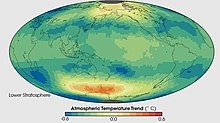|
|
| |
|
|
| |
|
|
|
|
| |
 |
| This image shows the
temperature trend in the lower stratosphere as
measured by a series of satellite-based
instruments between January 1979 and December
2005. The lower stratosphere is centered around
18 kilometers above Earth's surface. The
stratosphere image is dominated by blues and
greens, which indicates a cooling over time. |
Stratosphere
The stratosphere (/ˈstrætəˌsfɪər, -toʊ-/) is the second
major layer of Earth's atmosphere, just above the
troposphere, and below the mesosphere. The stratosphere
is stratified (layered) in temperature, with warmer
layers higher and cooler layers closer to the Earth;
this increase of temperature with altitude is a result
of the absorption of the Sun's ultraviolet radiation
(shortened UV) by the ozone layer. This is in contrast
to the troposphere, near the Earth's surface, where
temperature decreases with altitude. The border between
the troposphere and stratosphere, the tropopause, marks
where this temperature inversion begins. Near the
equator, the lower edge of the stratosphere is as high
as 20 km (66,000 ft; 12 mi), at midlatitudes around 10
km (33,000 ft; 6.2 mi), and at the poles about 7 km
(23,000 ft; 4.3 mi) Temperatures range from an average
of −51 °C (−60 °F; 220 K) near the tropopause to an
average of −15 °C (5.0 °F; 260 K) near the mesosphere.
Stratospheric temperatures also vary within the
stratosphere as the seasons change, reaching
particularly low temperatures in the polar night
(winter). Winds in the stratosphere can far exceed those
in the troposphere, reaching near 60 m/s (220 km/h; 130
mph) in the Southern polar vortex. |
|
Ozone and temperature
The mechanism describing the formation of the ozone
layer was described by British mathematician Sydney
Chapman in 1930. Molecular oxygen absorbs high energy
sunlight in the UV-C region, at wavelengths shorter than
about 240 nm. Radicals produced from the homolytically
split oxygen molecules combine with molecular oxygen to
form ozone. Ozone in turn is photolysed much more
rapidly than molecular oxygen as it has a stronger
absorption that occurs at longer wavelengths, where the
solar emission is more intense. Ozone (O3) photolysis
produces O and O2. The oxygen atom product combines with
atmospheric molecular oxygen to reform O3, releasing
heat. The rapid photolysis and reformation of ozone
heats the stratosphere resulting in a temperature
inversion. This increase of temperature with altitude is
characteristic of the stratosphere; its resistance to
vertical mixing means that it is stratified. Within the
stratosphere temperatures increase with altitude (see
temperature inversion); the top of the stratosphere has
a temperature of about 270 K (−3°C or 26.6°F).
This vertical stratification, with warmer layers above
and cooler layers below, makes the stratosphere
dynamically stable: there is no regular convection and
associated turbulence in this part of the atmosphere.
However, exceptionally energetic convection processes,
such as volcanic eruption columns and overshooting tops
in severe supercell thunderstorms, may carry convection
into the stratosphere on a very local and temporary
basis. Overall the attenuation of solar UV at
wavelengths that damage DNA by the ozone layer allows
life to exist on the surface of the planet outside of
the ocean. All air entering the stratosphere must pass
through the tropopause, the temperature minimum that
divides the troposphere and stratosphere. The rising air
is literally freeze dried; the stratosphere is a very
dry place. The top of the stratosphere is called the
stratopause, above which the temperature decreases with
height. |
|
Aircraft flight
Commercial airliners typically cruise at altitudes of
9–12 km (30,000–39,000 ft) which is in the lower reaches
of the stratosphere in temperate latitudes. This
optimizes fuel efficiency, mostly due to the low
temperatures encountered near the tropopause and low air
density, reducing parasitic drag on the airframe. Stated
another way, it allows the airliner to fly faster while
maintaining lift equal to the weight of the plane. (The
fuel consumption depends on the drag, which is related
to the lift by the lift-to-drag ratio.) It also allows
the airplane to stay above the turbulent weather of the
troposphere.
The Concorde aircraft cruised at mach 2 at about 19,000
m (62,000 ft), and the SR-71 cruised at mach 3 at 26,000
m (85,000 ft), all within the stratosphere.
Because the temperature in the tropopause and lower
stratosphere is largely constant with increasing
altitude, very little convection and its resultant
turbulence occurs there. Most turbulence at this
altitude is caused by variations in the jet stream and
other local wind shears, although areas of significant
convective activity (thunderstorms) in the troposphere
below may produce turbulence as a result of convective
overshoot.
On October 24, 2014, Alan Eustace became the record
holder for reaching the altitude record for a manned
balloon at 135,890 ft (41,419 m). Eustace also broke the
world records for vertical speed skydiving, reached with
a peak velocity of 1,321 km/h (822 mph) and total
freefall distance of 123,414 ft (37,617 m) – lasting
four minutes and 27 seconds. |
|
|
|
|
|
|
|
|
|
|
|
|
|
|
|
|
|
|
Search Fun Easy English |
|
|
|
|
|
|
|
|
|
|
|
|
|
|
|
About
Contact
Copyright
Resources
Site Map |